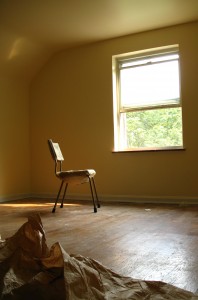 Prayer closet. Few words from my time in the Advanced Training Institute (ATI) cause me to shudder the way those do. I was on staff at the Indianapolis Training Center (ITC) in 1994 when the prayer closet was instituted. For the uninitiated, ITC was housed in an old 13-story hotel, just north of downtown Indianapolis.
Prayer closet. Few words from my time in the Advanced Training Institute (ATI) cause me to shudder the way those do. I was on staff at the Indianapolis Training Center (ITC) in 1994 when the prayer closet was instituted. For the uninitiated, ITC was housed in an old 13-story hotel, just north of downtown Indianapolis.
At the outset, the prayer closet was created by ITC leadership as a means of solitary confinement for youth offenders who had been referred to ITC by the juvenile court system. These rooms were sparsely furnished, with only a bed and table with a Bible and other IBLP materials, and the doorknob was reversed, effectively locking the person inside the room. Cameras were installed outside the door of the room so that it could be monitored from ITC’s front desk. In some cases, young men were assigned sentry duty outside the room.
At the outset, I didn’t give the prayer closet much thought. I figured that these kids were hardened criminals and probably deserved whatever it was that earned them time in the prayer closet. It happened frequently enough that I never thought about it–except for the time one kid broke the exterior window of his prayer closet room by throwing a chair through it.
That all changed one day at a staff meeting when ITC leadership announced room inspections and threatened that anyone who didn’t pass room inspection would be sent to a prayer closet for a few days. My best friend leaned over and quipped, “This is the kind of thing cults do.”
When I left ITC a short time later, I wasn’t aware of any non-juvenile court referral being sent to the prayer closet. In talking with other ATI students, however, I have learned that it didn’t take long for ITC leadership to cross that line. And though it was later referred to as the prayer room (or quiet room) and ITC ceased the practice of reversing the doorknobs to lock people inside the room, the psychological confinement continued, and, as the following anecdotes illustrate, these rooms were used to discipline staff members for petty offenses. (Pseudonyms are used to protect the identity and dignity of these individuals.)
- “Miranda” was sent to the prayer room for three days because she was out of her room past curfew a few times.
- “Brittany” was sent to the prayer room for several days for saying something that “offended” another girl. Though they brought her food, she was too humiliated to eat it.
- “Kayla” was directly threatened with time in a prayer room for “sneaking Christian rock music.”
- “Denise” was threatened with time in a prayer room for requesting something and leadership telling her she was discontent.
- “Renee” attended Sound Foundations and says she was lucky not to be sent to the prayer room. “I was often in trouble for things like ‘carrying myself seductively,’ and showing my collarbone (we actually had a session where we discussed the sensuality of the collarbone in relation to defrauding!).”
At some point the use of the prayer rooms (and other activities) for court referred juvenile offenders was investigated by Indiana Family and Social Services. Though they found the claims to be unsubstantiated, Mr. Gothard himself admitted at least the existence of the room (See this investigative story by an Indianapolis news team).
Thankfully, ITC has ceased operations and the property has been sold. I do not know whether the practice of using prayer closets for discipline was used in other Institute in Basic Life Principles (IBLP) locations, but, in hindsight, I consider it to be one of the most shameful practices undertaken by IBLP over the years.






















All the staff members you mention as sent to the "prayer closet" are women. Were women more likely to be disciplined for these kinds of petty "offenses" during your experiences with ITC?
Kate - not necessarily, in my experience. When my brother went to Life Focus, I remember him telling about several different guys who were sent to the prayer room for various offenses.
From what I can tell, the ITC is still alive and well: http://iblp.org/iblp/about/whatwedo/trainingcenters/. Am I missing something here, as the article clearly states, "Thankfully, ITC has ceased operations and the property has been sold"? I do know that ITC no longer works with juvenile delinquents.
I was at the ITC for a web design class in 2008 and found it to be a rather odd place. Can't say much else besides the fact that I would not like to return to the ITC ever again. I thank Jesus for delivering me from the bondage of my own self-effort and setting me free to live the Christian life in the power of the Spirit!
The training center in downtown Indianapolis has been sold (the 13-story hotel), but the Institute still has a South Campus in Indianapolis.
My family was at ITC for several years. I worked with the LIT (Leadership In Training) program. I left on my own, and have had a major rift with my family since then, because I was threatened with an extended stay in the "Prayer closet"
One of the young men I worked with there, held the "record" for staying in there (last I knew), and it was at just shy of 3 months.
3 MONTHS of living in the above described room.
In my opinion "psychological confinement" in NO WAY covers this abuse of power and humans.
I'm forever thankful I was able to break away from that place. I lived in a truck for months and it was so much better than what I had there...
I struggle still today with the issues that Gothard and his cult visited on my family. Thank you for your work with this site!
This practice was used on ME at IBLP Headquarters in the fall of 1996. I was kept in solitary confinement for 3 days without food or human interaction until I repented (ie, earned back Mr. Gothard's approval) of my romantic involvement with a boy who had also been at the HQ.
correction: fall of 1995.
Sarah, I had NO IDEA this was happening OR we would have 1. protested and 2 left association immediately. Is this when you left? HORRID. WRONG. CRAZY. I guess these all equal CULT. So sorry.
That is so terrible!!! I am so sorry that happened!!!
I must confess that when I was in Indy in 93 (I think) I guarded a "prayer room" for one hour once so that the usual person could go get lunch for herself and the person inside. I just brought some crocheting to do while I waited. I feel so badly that I participated!!! Ugh!!!
I have two friends that experienced the prayer room while in Life Focus. One for 7 weeks, one for 3 weeks. How they have not completely turned their back on God - the God they were shown - I have no idea! They have a resilience that amazes me.
i am also ashamed to have been a part of such a practice. this has weighed so heavy on my conscience. God is good to extend grace to those of us who were idiots back then, behaving in our kool-aid drinking ways.
for further review: http://www.wthr.com/global/story.asp?s=818906&ClientType=Printable
"...we actually had a session where we discussed the sensuality of the collarbone in relation to defrauding."
This made me laugh out loud. Because, you know, you hear so many worldly boys talking about what great collarbones some girls have.
LOL Wendy! That's such a hilarious thought. Can't say I've EVER heard that in Real Life! ;-)
I am a guy and let's just say I'm not a collarbone man (nor have any of my guy friends ever confessed to being one either.
ha
I was at ITC Indianapolis (_not_ South Campus) for most of 1996, and I can confirm that at least one boy was in solitary confinement for three months.
[...] Solitary confinement for days [...]
[…] Indianapolis Training Center (ITC) for the second Life Focus class. He spent several weeks in the “Prayer room” for a very minor offense. After not hearing from their son for several weeks, Paul’s parents […]
[…] Life Focus program. But one experience that stands out in my mind was when I was confined to the Prayer Room during Life Focus […]
I was almost 30 years old and was confined to my room for 7 days. They didn't tell me why till the 4th day. My supervisor said I rolled my eyes at her. Yes, I was frustrated with her, she was insisting that I do something the wrong way. I was trained, she wasn't. I don't remember rolling my eyes or being disrespectful in any way. I think she felt threatened by me.
It was humiliating and the crazy long projects didn't change anything in my life. I had to do things like memorize Heb 11 and several other chapters. Heb 11 was the whopper though. I had to write a detailed outline of the advanced seminar book. Write a paper on every character trait and how I fell short of that trait in my life etc. If my authorities had heard from the Lord I'm sure I would have at least gained something from the 7 hrs a day of projects.
Regardless, the Lord used that time in my life. I learned new things about Him and myself - nothing to do with my eye roll. I'm not sure why I stayed after that. I stayed a long time. As I've been reading over this site I can't believe I stayed at the ITC through so much of this stuff.
It took me a while to "De-program" Neil Anderson's book Breaking The Bondage of Legalism was life-giving for me. I learned a lot of good things in my time with ATI and I have piles of good memories. The bad stuff doesn't bother me anymore. I think I can safely say I've healed.